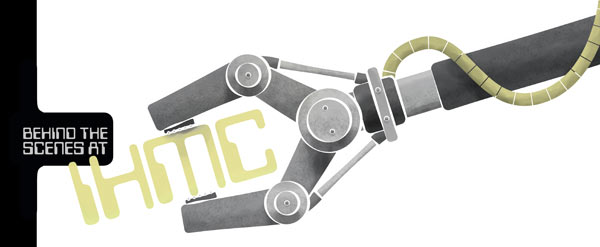
Five years ago, a transformation took place at the old Marion County Library building on Osceola Avenue. Out came the dark, paneled walls, the rows of bookshelves and that old, dark carpeting, and in went sleek, modern furniture, lots of natural light and panels of whiteboard. The renovation was done so well that it’s the only remodeled building in Florida to be awarded the LEED (Leadership in Energy and Environmental Design) gold level certification by the U.S. Green Building Council. Ocalans were intrigued, if not somewhat confused, by the strange high-tech organization that quietly set up shop in the old building. What, exactly, is going on in there?
The Institute for Human and Machine Cognition is not a company but rather a research institute that’s part of the State University System of Florida. The university system is comprised of 12 state universities, two research institutes, IHMC and the Moffitt Cancer and Research Institute. IHMC is headquartered in downtown Pensacola and employs over 100 people, of which 80 percent are scientific and technical personnel. The Ocala institute houses 15 research scientists and support personnel who spend their days working on transformative research that could one day change the world—or at least the way humans use technology to interact with the world.
Human and machine cognition refers to the relationship between humans and machines. In the past, humans have always had to adapt to machines. As technology advanced, so did we, learning how to apply it to our lives. Just think about satellite television and smartphones. These technological advances didn’t even exist until recently. Now, some of us couldn’t imagine life without them. These advances in technology have drastically changed the way we live from day to day. Take handwriting, for example. Computers and other machines have vastly changed our need for handwritten communication. We have adapted to using a keyboard, stylus, touch pad and voice-controlled devices. Well, the research being done at IHMC inverts that process. IHMC research scientists are actually teaching machines how to adapt to humans. Their research focuses on improving human performance in three main areas: mobility, sensory and cognitive assistance.
“One aspect of the work we do focuses on wounded service members,” says John “Row” Rogacki, associate director for IHMC and a former administrator and researcher with the Air Force, NASA and the University of Florida. “Due to the advances in the body armor we have for our sailors and soldiers, many of our men and women are returning home alive but often missing limbs or eyesight. IHMC’s scientists compete for contracts and grants to research and develop technologies that can assist these injured service members with performing simple tasks and reintegrating into society.”
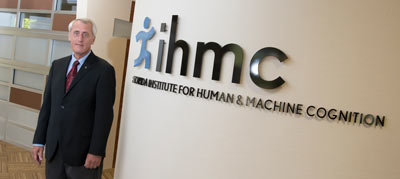
Earlier this year, a team from IHMC took first place out of 26 of the top robotics research groups in the world in the initial simulation stage of the DARPA (Defense Advanced Research Projects Agency) Virtual Robotics Challenge. DARPA’s goal is to design a robot that can perform tasks in spaces that would be dangerous for a human operator, such as enter a disaster area to repair a radiation leak, utilizing the tools a human would use to repair it, even navigating a vehicle if necessary.
“Useful robots are those that can function in the world that humans have created for ourselves,” says Rogacki. With that sentiment in mind, IHMC researchers have designed a bipedal robot that can step over obstacles or across uneven terrain and maintain its balance. This is key to developing a robot that can work side by side with humans. Because many robots are programmed geometrically, meaning their movements are controlled by angle and distance, if anything gets in their way, they usually just run into the obstacle. IHMC is working on the human-machine interface by using sensors that will allow the robot to stop or change direction when in contact with an external object, increasing the safety of the robot. One biologically inspired robot design looks like a 6-foot-tall ostrich, with just a body and legs, but no head or arms. Its gait looks amazingly natural, and the robot was even put to the test on a horse treadmill.
“Right now, the fastest a bipedal robot can run is about 13 miles per hour,” says Rogacki. “We are working on getting that up to 30 miles per hour, or possibly even faster.”
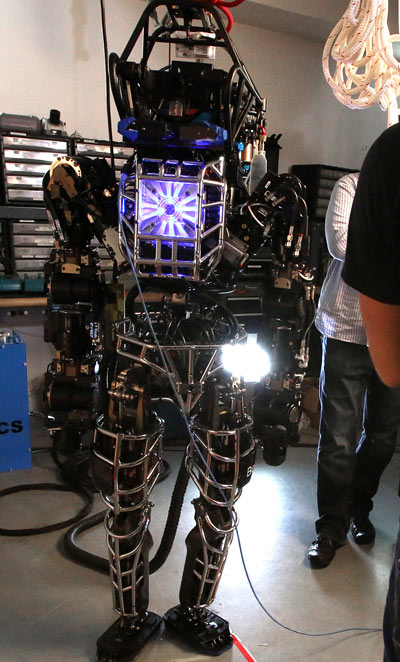
Here’s just some of the research being conducted at IHMC, both in Ocala and Pensacola. Their motto, “Research that makes a difference…that makes a difference,” is evident when you consider everything the researchers are working toward.
Mobility Assistance
When a person suffers a brain injury resulting in paralysis, it’s possible to enable a different part of the brain to take over the function that was once commanded by the injured portion. One application is the development of passive exoskeletons that assist partially paralyzed people with using their limbs again. Exoskeleton means the robotic device is attached to the outside of the body; passive means it is unpowered. Researchers were able to help a young man, who was paralyzed on the left side of his body as the result of a military operation, walk normally again.
The initial problem was that he was unable to step down on the sole of his left foot. His weight landed on the outside of his foot, which was very painful, and the problem could not be corrected with rehabilitation. The researchers at IHMC fit him with a passive exoskeleton, which caused his foot to land more naturally. After 30 minutes of wearing the device, he was able to walk normally without the exoskeleton. After practicing for a while longer, he was able to give up his cane. The device did not retrain his leg; it retrained his brain to send the right signals to his muscles.
IHMC has recently changed its focus from unpowered exoskeletons to powered exoskeletons. IHMC’s interest is to enable paraplegics to walk. An example includes the case of a young woman who suffered a T-12 spinal injury that left her unable to stand or walk. An exoskeleton gives her a structure that’s fitted to her bone size. Equipped with a power source, the machine will allow her to integrate back into walking society.
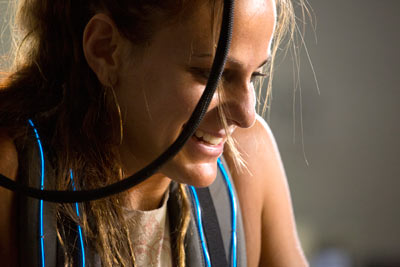
“It’s not the world that needs to change, it’s our bodies that need to change,” she says. “When I put it on, I’m complete again.” Because she has no feeling in her legs or feet, she still has to use crutches to ‘feel’ where she is touching the ground.
NASA is also interested in the use of powered exoskeletons to enable astronauts to maintain muscle and bone mass while in space. As part of IHMC’s Blue Sky program, IHMC worked with NASA’s Johnson Space Center to help design the Lunar Electric Rover. In this case, the problem involves improving a transportation capability for planetary surface exploration. When Apollo astronauts were on the moon, they rode around in a vehicle that resembled a high-tech golf cart. The problem was, if the cart broke down and the astronauts had to get back to the spacecraft on foot, it could take some time, leaving the astronauts vulnerable to solar radiation. Ground control would normally receive 20 to 30 minutes warning of a solar flare coming between the time it could be sensed on Earth and when it would reach the moon. On Earth, the atmosphere protects us from solar flares, but on the moon, there is no such protection. A big advantage of the Lunar Electric Rover is that the passenger compartment is lined with a layer of water, which protects the astronauts from solar radiation.
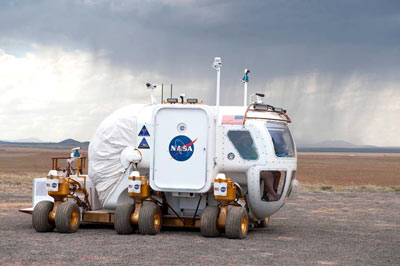
The Blue Sky program came up with a vehicle that can travel over all types of terrain with the use of extremely powerful computers. The 4-ton vehicle can climb up 30-degree slopes and can change height to increase visibility. The vehicle, a sort of motor home for astronauts, has beds, a toilet, an iPod dock and even a home cinema. To exit the vehicle, the astronaut steps right into his or her spacesuit, which acts as the outer door and detaches from the vehicle. The hop-in space suit is a big innovation. To leave the space station to go out for a spacewalk, astronauts have to put on their spacesuit and go into a decompression chamber where they pump all the air out to create a near-perfect vacuum, sometimes taking in excess of 90 minutes. When they return from the spacewalk, they spend another 45 to 60 minutes re-pressurizing. Although the suits are very complex, they are also very unforgiving, sometimes leaving astronauts with scrapes, bruises and missing nails. Often, astronauts have to go on bed rest after being in the suit. The entry and exit spacesuit doesn’t need to be decompressed and re-pressurized in a separate compartment, thereby decreasing the amount of time the astronauts are in it and reducing the chance of injury.
Mobility assistance can also mean giving military personnel, and others, super-human capabilities. Powered exoskeletons can help underwater swimmers swim farther and faster or allow a soldier to carry a 200-pound pack long distances by giving them powered robotic legs.
Sensory Substitution
The next hurdle in the development of the powered exoskeleton is to develop feedback from the device to the brain, so that crutches will not be necessary. This is where mobility assistance and sensory substitution come together. People who have lost feeling in their extremities due to spinal cord injuries cannot perceive the position of their limbs or feel when their limbs make contact with the ground or other obstacles. Sensory substitution involves using tactile displays on the torso, abdomen and even the tongue. For example, sensors can be placed on almost 1,000 points on the sole of the foot, and each of these sensor points relays a differential voltage to a receptor area, which may be a small pad held on the tongue. The person learns to perceive balance, or where on the foot the body is loading its weight, by feeling the stimulus on the receptor pad. So just like a blind person learns to read with his fingertips, a paralyzed person can learn to feel his body weight with his tongue.
A similar example of sensory substitution technology involves people who have lost their eyesight due to macular degeneration or trauma, as in the case of many soldiers who have encountered roadside bomb explosions. Researchers are working on finding another way to get visual data to the brain if the eyes aren’t working. Your eyes don’t see; rather, the eyes are the lenses that capture images. The lens sends data to the brain, which interprets the data and perceives images. IHMC is working with a tongue interface device patented by a Wisconsin-based company named Wicab that provides an alternate pathway for visual data to be sent to the brain. A camera, attached to eyeglasses, pixilates the image in front of the wearer and transmits the image as differential voltages to the tongue interface. The brain can actually be trained to see the images transmitted through the tongue interface. The images transmitted are not in full resolution and are in black and white but can enable a blind person to navigate obstacles in front of them. They have even had people read an eye chart to the 20-60 level, an amazing achievement for someone who has lost their eyesight.
Cognitive Assistance
An example of a cognitive assistance project involves improving instrument displays in aircraft cockpits. When flying an aircraft, in addition to focusing on their mission, pilots have to constantly monitor many different gauges and dials. Certainly this takes a lot of mental energy to process. Researchers have come up with a human-centered flight display that relieves a lot of the mental effort. Basically, everything a pilot needs to know about the aircraft is displayed in a more intuitive form on the display. The display has been developed for both fixed wing and rotary wing (helicopters) aircraft. Flying a helicopter is very challenging. The most difficult part is learning to hover because the pilot needs to use both hands and both feet in a coordinated fashion. This IHMC display, when used for training, allows pilots to learn to hover much easier.
Cyber security is a very big issue in today’s society.
“The free world is constantly under attack, from everything from teenage kids who think it’s funny to send you a virus to professional thieves stealing from banks to adversaries stealing military secrets,” says Rogacki. “Our country is putting a lot of resources into cyber security.”
One project the IHMC is working on for cyber defenders is “cyber sense-making.” In cyber space, events happen quickly; threats over a network come rapidly and often with very large amounts of information. The researchers at IHMC have developed a way of highlighting information as visual streams, making it easier to identify potential cyber attacks.
Another advance, Companion Technology is an effort to equip individuals who might need extra help cognitively because of Alzheimer’s or dementia. IHMC scientist Yorick Wilks has created a virtual companion—playfully named Wig Dog—that can actually communicate with an individual. Wig Dog is presented with photographs of the individual’s family and friends, and she interviews the person about the people in the photographs, storing the information. Wig Dog also stores information entered into the computer, like phone numbers or medication schedules and can read to the person from online news and entertainment sources. Unlike other voice control applications, which require you to speak in a precise, controlled manner, Wig Dog understands you in the language you are naturally speaking. Aside from helping the elderly or mentally challenged, this application can potentially be used for language training.
IHMC Community Outreach Programs
Science Saturdays
Held once a month during the school year, Science Saturdays offer third- through fifth-graders hands-on science experiments to give them confidence with science. Activities are lead by IHMC research scientists and local science professionals and are all about having fun. Robotics and computer programming camps are also offered for students during the summer months.
Evening Lecture Series
This award-winning program welcomes the public for a community forum on meaningful and timely topics and is presented by experts in many fields of study. The next lecture is “The D-Lightful Vitamin D for Good Health,” presented by Michael Holick, on November 21.
To find out more about these programs, visit ihmc.us and click on “Outreach” or call (352) 387-3050.






